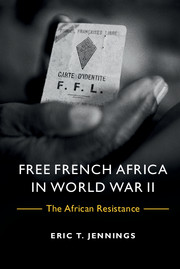Book contents
- Frontmatter
- Contents
- Figures
- Maps
- Acknowledgments
- Archival Abbreviations
- Glossary
- Introduction
- PART I FREE FRANCE'S AFRICAN GAMBIT
- PART II THE WAR
- PART III RESOURCE EXTRACTION, WARTIME ABUSES, AND AFRICAN EXPERIENCES
- Introduction to Part III
- 6 Rubber, Gold, and the Battle for Resources
- 7 Colonial Practices and Wartime Imperatives
- Epilogue
- Conclusion
- Bibliography
- Index
6 - Rubber, Gold, and the Battle for Resources
from PART III - RESOURCE EXTRACTION, WARTIME ABUSES, AND AFRICAN EXPERIENCES
Published online by Cambridge University Press: 05 August 2015
- Frontmatter
- Contents
- Figures
- Maps
- Acknowledgments
- Archival Abbreviations
- Glossary
- Introduction
- PART I FREE FRANCE'S AFRICAN GAMBIT
- PART II THE WAR
- PART III RESOURCE EXTRACTION, WARTIME ABUSES, AND AFRICAN EXPERIENCES
- Introduction to Part III
- 6 Rubber, Gold, and the Battle for Resources
- 7 Colonial Practices and Wartime Imperatives
- Epilogue
- Conclusion
- Bibliography
- Index
Summary
A 1947 documentary entitled Autour de Brazzaville, filmed partly by avant-garde photographer Germaine Krull, sets about informing the French public about what “Equatorial Africa brought Free France” during World War II. While the film exalts the troops from these territories and chronicles the rallying of the colonies in question in August 1940, not to mention the heroism of doctors and the development of infrastructures under Gaullist rule, it nonetheless depicts the region's chief contribution to the Allied cause as resource-based. FEA had “offered” massive amounts of rubber, gold, and to a lesser extent, wood. Indeed, a 1943 order outlining Krull's mission describes plainly “a film about the production of gold, rubber and timber.” It is precisely this focus on extraction that constitutes the most captivating aspect of the film today, more than its perhaps predictable civilizing discourse and condescending tone (“A hundred years earlier FEA had been in the stone age,” trumpets the boisterous narrator). Frame upon frame focuses on Free French Africa's contribution of natural resources. One is left thinking that FEA and Cameroon must have been bled dry in the span of four years.
Rubber is closely linked to the brutality for which the Congo Free State and the Belgian Congo became so notorious in the late nineteenth and early twentieth century. The regions that would subsequently be known as FEA proved little different in this respect. In the 1890s, rubber was collected in lieu of taxes. Concessionary companies dealing in wood and rubber carved up the area. Gabonese like Vincent de Paul Nyonda, Valére Mourigou, and Pototu Mbumb reported acts of sadistic cruelty linked to rubber production: rapes, forced incest, and other sexual crimes committed on those unfortunate enough to have brought rubber that the authorities deemed to be of insufficient or inferior quality.
This first rubber fever peaked in 1917. In the wake of the Great War, the commodity's price collapsed. Thereafter, wild rubber collection dropped considerably across Africa, including in FEA and Cameroon, even though a British scheme to limit production in the 1920s briefly caused rubber demand to rebound.
- Type
- Chapter
- Information
- Free French Africa in World War IIThe African Resistance, pp. 179 - 216Publisher: Cambridge University PressPrint publication year: 2015



